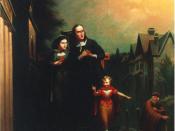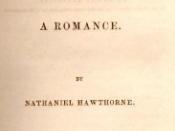One main theme present in the work "The Scarlet Lette" is that of sin and guilt. Nathaniel Hawthorne attempts to show how guilt can be a form of everlasting punishment. The book represents sin and guilt through symbolism and character development. In his novel, "The Scarlet Letter", Nathaniel Hawthorne explains how the punishment of guilt causes the most suffering among those affected.
As with any piece, symbolism plays an important role in representing the main ideas of a novel. The plot in "The Scarlet Letter" revolves around three significant events that describe the development of the story. As both starting point and ending point of the novel, the scaffold scenes hold symbolic meaning.
The first scaffold scene introduces the reader to the story, plot, and characters. The reader meets Hester Prynn and soon discovers the means of her sin. Hester's thoughts as she stands before the public are described at the end of the second chapter.
"Could it be true? She clutched the child so fiercely to her breast, that it sent forth a cry; she turned her eyes downward at the scarlet letter, and even touched it with her finger, to assure herself that the infant and the shame were real. Yes! -these were her realities, -all else had vanished!" (Hawthorne, 55). At this point, Hester is still quite ashamed of her sin of adultery, and may not want to acknowledge the reality of it. As Hester is accused of her crime, the first scaffold scene represents committing and being accused of a sin.
By the time the second scaffold scene approaches, seven years later, the reader should know that Hester's 'partner in crime' is the minister Arthur Dimmesdale. Thus far in the novel, Dimmesdale has kept his sin a secret from society. During...


